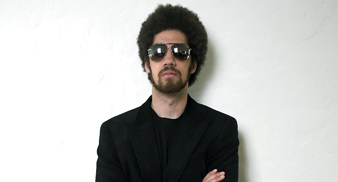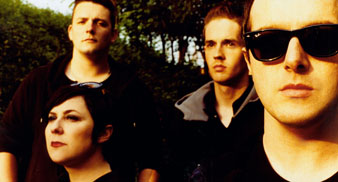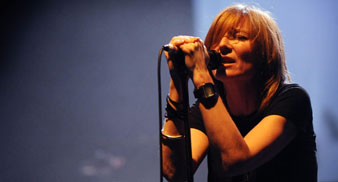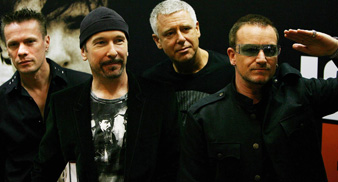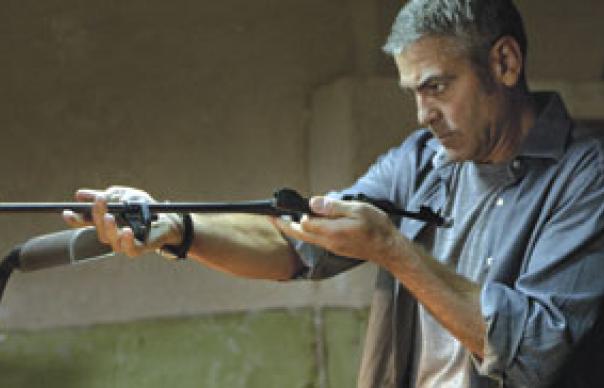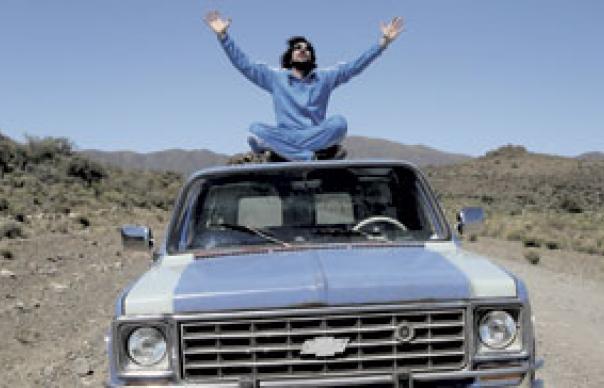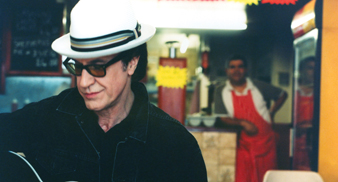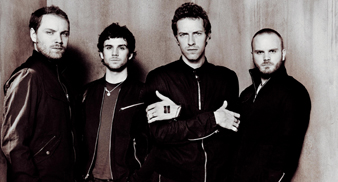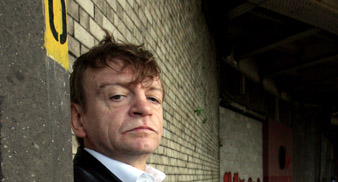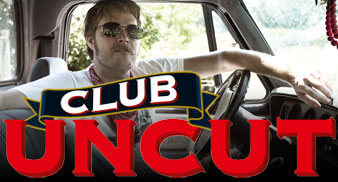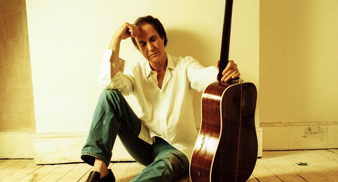Paul Weller is the winner of the Uncut Music Award 2010. His album, “Wake Up The Nation”, is the third winner of the prestigious award, following the triumphs of Fleet Foxes and Tinariwen in 2008 and 2009. Watch the judges making their decision after the jump…
Paul Weller Wins The Uncut Music Award 2010
Arcade Fire give hints as to what set they’ll play on UK and Ireland tour
Fans heading to Arcade Fire's UK and Ireland tour dates from Wednesday (December 1) have been given a hint as to what songs the band will play. The Canadian collective play eight gigs, calling at venues in London, Dublin, Manchester, Birmingham, Glasgow and Cardiff. Recent gigs at Lyon's Halle Tony Garnier (November 26) and Munich's Zenith (28) have seen them play a set featuring material from throughout their career, but with a heavier leaning on latest effort 'The Suburbs'. As is traditional, the band have been ending their gigs with 'Wake Up'. The band's setlist in Munich was: 'Ready To Start' 'Month Of May' 'Neighborhood #2 (Laika)' 'No Cars Go' 'Haïti' 'Sprawl II (Mountains Beyond Mountains)' 'Modern Man' 'Rococo' 'My Body Is A Cage' 'The Suburbs' 'Intervention' 'Neighborhood #3 (Power Out)' 'Rebellion (Lies)' 'Neighborhood #1 (Tunnels)' 'We Used to Wait' 'Keep the Car Running' 'Wake Up' Arcade Fire kick off their UK and Ireland tour on Wednesday at London's O2 Arena. Tickets for the gigs are on sale now. Latest music and film news on Uncut.co.uk. Uncut have teamed up with Sonic Editions to curate a number of limited-edition framed iconic rock photographs, featuring the likes of Pink Floyd, Bob Dylan and The Clash. View the full collection here.
Fans heading to Arcade Fire‘s UK and Ireland tour dates from Wednesday (December 1) have been given a hint as to what songs the band will play.
The Canadian collective play eight gigs, calling at venues in London, Dublin, Manchester, Birmingham, Glasgow and Cardiff.
Recent gigs at Lyon‘s Halle Tony Garnier (November 26) and Munich‘s Zenith (28) have seen them play a set featuring material from throughout their career, but with a heavier leaning on latest effort ‘The Suburbs’. As is traditional, the band have been ending their gigs with ‘Wake Up’.
The band’s setlist in Munich was:
‘Ready To Start’
‘Month Of May’
‘Neighborhood #2 (Laika)’
‘No Cars Go’
‘Haïti’
‘Sprawl II (Mountains Beyond Mountains)’
‘Modern Man’
‘Rococo’
‘My Body Is A Cage’
‘The Suburbs’
‘Intervention’
‘Neighborhood #3 (Power Out)’
‘Rebellion (Lies)’
‘Neighborhood #1 (Tunnels)’
‘We Used to Wait’
‘Keep the Car Running’
‘Wake Up’
Arcade Fire kick off their UK and Ireland tour on Wednesday at London‘s O2 Arena.
Tickets for the gigs are on sale now.
Latest music and film news on Uncut.co.uk.
Uncut have teamed up with Sonic Editions to curate a number of limited-edition framed iconic rock photographs, featuring the likes of Pink Floyd, Bob Dylan and The Clash. View the full collection here.
Gil Scott Heron to release album with The xx’s Jamie Smith
The xx‘s Jamie Smith‘s reworking of Gil Scott-Heron‘s latest album ‘Im New Here’ is set for release on February 21.
The album, named ‘We’re New Here’, will preceded by the release of a single, ‘NY Is Killing Me’. Scroll down and click below to listen to it.
Smith has reworked 13 songs from the original album for the new release, set to come out on CD, vinyl, vinyl box set and as a download.
See Werenewhere.com for more information.
The tracklisting of ‘We’re New Here’ is:
‘I’m New Here’
‘Home’
‘I’ve Been Me (Interlude)’
‘Running’
‘My Cloud’
‘Certain Things (Interlude)’
‘The Crutch’
‘Ur Soul and Mine’
‘Parents (Interlude)’
‘Piano Player’
‘NY Is Killing Me’
‘Jazz (Interlude)’
‘I’ll Take Care Of U’
Latest music and film news on Uncut.co.uk.
Uncut have teamed up with Sonic Editions to curate a number of limited-edition framed iconic rock photographs, featuring the likes of Pink Floyd, Bob Dylan and The Clash. View the full collection here.
Danger Mouse announces tracklisting for Jack White-featuring album
The tracklisting for Danger Mouse and Italian composer Daniele Luppi's forthcoming 'Rome' album has been revealed – scroll down to read it. The album features vocals from The White Stripes' Jack White and Norah Jones. It was recorded in parts over the past five years, and was inspired by the film soundtrack work of Ennio Morricone. The tracklisting of 'Rome' is: 'Theme Of Rome' 'The Rose With The Broken Neck' 'Morning Fog (interlude)' 'Season's Trees' 'Her Hollow Ways (interlude)' 'Roman Blue' 'Two Against One' 'The Gambling Priest' 'The World (interlude)' 'Black' 'The Matador Has Fallen' 'Morning Fog' 'Problem Queen' 'Her Hollow Ways' 'The World' Latest music and film news on Uncut.co.uk. Uncut have teamed up with Sonic Editions to curate a number of limited-edition framed iconic rock photographs, featuring the likes of Pink Floyd, Bob Dylan and The Clash. View the full collection here.
The tracklisting for Danger Mouse and Italian composer Daniele Luppi‘s forthcoming ‘Rome’ album has been revealed – scroll down to read it.
The album features vocals from The White Stripes‘ Jack White and Norah Jones. It was recorded in parts over the past five years, and was inspired by the film soundtrack work of Ennio Morricone.
The tracklisting of ‘Rome’ is:
‘Theme Of Rome’
‘The Rose With The Broken Neck’
‘Morning Fog (interlude)’
‘Season’s Trees’
‘Her Hollow Ways (interlude)’
‘Roman Blue’
‘Two Against One’
‘The Gambling Priest’
‘The World (interlude)’
‘Black’
‘The Matador Has Fallen’
‘Morning Fog’
‘Problem Queen’
‘Her Hollow Ways’
‘The World’
Latest music and film news on Uncut.co.uk.
Uncut have teamed up with Sonic Editions to curate a number of limited-edition framed iconic rock photographs, featuring the likes of Pink Floyd, Bob Dylan and The Clash. View the full collection here.
Earth: “Angels Of Darkness, Demons Of Light 1”
A raised eyebrow last week, when the new Earth album arrived, accompanied by a press release citing Pentangle, Fairport Convention and Tinariwen as key influences. It’s been a fair while, of course, since Dylan Carlson’s outfit made music quite so doomy and reductive as their reputation. Nevertheless, folk-rock and Tuareg jams feel like they still might be a bit of a stretch, and so “Angels Of Darkness, Demons Of Light 1” proves. Much of the music in these five long tracks initially feels very much like a continuation of “The Bees Made Honey In The Lion’s Skull”, a sort of blasted Americana, more or less tectonic at the speed it evolves. After a few listens, though, I’ve started spotting nuances in this gravity-heavy, hugely impressive music. Somewhere in the 12-odd minutes of “Father Midnight” emerges something of a jazz-tinged roll to the rhythm section, a brushed and high looseness underpinning Carlson’s still blackened riffing. A few years back, I came across the German doom-jazz band, Bohren Und Der Club Of Gore, evidently Earth fans. It now seems as if Carlson might just be a Bohren fan in return, given the monolithic swing that Earth – currently a quartet – are practising. When I blogged about “The Bees Made Honey…”, I mentioned how Earth had belatedly moved into a grand tradition, that what was once unanchored noise-rock had grown backwards towards the blues. On “Angels Of Darkness”, that process seems even more advanced: as “Descent To The Zenith” unfolds, it’s not too far-fetched to suggest Earth have found a groove. It’s not one immediately comparable to that of Tinariwen, but a kindred sense of letting a serpentine groove work itself out, in its own time, driven by its own imperturbable forward motion, is not entirely dissimilar. British folk-rock, however, remains harder to spot among the rubble. Lori Goldston’s cello comes very much into the foreground on the 20-minute closing title track, circling ponderously and reminding me very slightly of a Nick Drake track or two. For all the imprecations of doom in the language that Carlson uses for his music, though, “Angels Of Darkness…” feels serenely expansive; the work of a band heading inexorably, but extremely slowly, towards a kind of rock orthodoxy. Give Carlson another 20 years, and he might be tantalisingly close. In the meantime, though, the journey is remarkable – and hellishly hard, as an aside, to write about sentiently today.
A raised eyebrow last week, when the new Earth album arrived, accompanied by a press release citing Pentangle, Fairport Convention and Tinariwen as key influences. It’s been a fair while, of course, since Dylan Carlson’s outfit made music quite so doomy and reductive as their reputation.
Primal Scream, Olympia, London, November 26, 2010
Primal Scream have long held firm to the belief that the past is a hostile foreign country, much of it best left unvisited. It’s a condition that extends, for the most part, to their first two albums. Rarely – if ever – do they perform any of those tracks live, while 2004’s Dirty Hits compilation did a very good job of pretending nothing existed prior to the band’s self-declared Year Zero: Screamdelica. But it’s a strange policy, really. After all, without that self-titled second album – in particular the ballad “I’m Losing More Than I’ll Ever Have” – Screamadelica arguably wouldn’t exist, and we wouldn’t be here tonight.
Glasvegas to make live return with January tour
Glasvegas are set to make their live return in Scotland in January.
The band, who have been recording their second album in Los Angeles this year, will play eight gigs in their home country and have promised to play a full UK tour in spring.
“We love playing live,” they said. “We love Scotland. We wanted to discover more of our own country doing what we are passionate about. Our new songs will be heard live first in our home country and we’re very proud to be able to do that.”
The band’s second album, the follow-up to their 2009 self-titled debut, will be out some time soon after the Scottish shows.
Glasvegas will play:
Orkney Kirkwall Fusion (January 6)
Wick Assembly Rooms (7)
Forres The Loft (8)
Oban Corran Halls (10)
Dunoon The Queen’s Hall (11)
Troon Concert Hall (12)
Hawick Town Hall (14)
Dunfermline Velocity (15)
Tickets go on sale on Saturday (November 27) at 9am (GMT). To check the availability of [url=http://www.seetickets.com/see/event.asp?artist=glasvegas&filler1=see&filler3=id1nmestory]Glasvegas tickets[/url] and get all the latest listings, go to [url=http://www.nme.com/gigs]NME.COM/TICKETS[/url] now, or call 0871 230 1094.
Latest music and film news on Uncut.co.uk.
Uncut have teamed up with Sonic Editions to curate a number of limited-edition framed iconic rock photographs, featuring the likes of Pink Floyd, Bob Dylan and The Clash. View the full collection here.
Portishead added to Benicassim 2011 festival bill
Portishead have been added to the bill for next year’s Benicassim festival in Spain.
They join [url=http://www.nme.com/news/the-strokes/53983]The Strokes, Arctic Monkeys and Primal Scream for the four-day bash[/url] which will be held from July 14-17.
Tickets for the festival are on sale now. To check the availability of [url=http://www.seetickets.com/see/event.asp?artist=benicassim&filler1=see&filler3=id1nmestory]Benicassim tickets[/url] and get all the latest listings, go to [url=http://www.nme.com/gigs]NME.COM/TICKETS[/url] now, or call [B]0871 230 1094[/B].
Portishead also recently confirmed [url=http://www.nme.com/news/portishead/53985]plans to curate a two-day All Tomorrow’s Parties[/url] event in July 2011. They will perform alongside Factory Floor, DOOM, Swans, Liars, Beach House and Company Flow, who will play with their original line-up and for the first time in the UK for 10 years.
Latest music and film news on Uncut.co.uk.
Uncut have teamed up with Sonic Editions to curate a number of limited-edition framed iconic rock photographs, featuring the likes of Pink Floyd, Bob Dylan and The Clash. View the full collection here.
U2 and Jay-Z pay tribute to dead New Zealand mine workers
U2 and Jay-Z have paid tribute to the 29 workers killed by an explosion in a New Zealand coal mine.
Both acts honoured those lost in the blast at the Pike River mine on the South Island on Wednesday (November 24), during a gig at Auckland‘s Mt. Smart Stadium last night (25).
“People have ways of dealing with grief, in Ireland we sing,” Bono told the crowd as the band launched into ‘I Still Haven’t Found What I’m Looking For’ and a rare outing for 1987’s ‘One Tree Hill’.
The names of the 29 dead miners scrolled across big screens as the band performed the two crowd favourites, reports the New Zealand Herald.
Earlier Jay-Z, supporting the band on their tour of the country, paid his respects by dedicating ‘Young Forever’ to the miners. “They will always be in our hearts and they will always be forever young,” he said.
The dead miners, which included 24 New Zealanders, two Australians, two Britons and a South African, died after a second explosion on Wednesday. They became trapped after an initial blast in the mine last Friday.
Latest music and film news on Uncut.co.uk.
Uncut have teamed up with Sonic Editions to curate a number of limited-edition framed iconic rock photographs, featuring the likes of Pink Floyd, Bob Dylan and The Clash. View the full collection here.
THE AMERICAN
DIRECTED BY Anton Corbijn
STARRING George Clooney, Violante Placido, Thekla Reuten
You can understand, in the wake of the Bourne trinity, why The American is being marketed as an action-packed Euro-thriller full of big guns, breathless chases and attractive exponents of espionage. Those expecting gung-ho kills and spills, however, may be frustrated.
Anton Corbijn’s second film is rather a meditation on the genre, an elegiac musing on the role of the lone, ageing assassin. Like Melville’s Le Samourai, it focuses on a ruthless, now wearying man of cold blood and stern rituals whose Achilles heel is a yen for intimacy and connection. It’s a study of a battered soul wondering if redemption might be worth a shot after all. And so, in the film’s ellipses and longueurs during what is – despite this approach – a completely riveting noir plot, Corbijn comes up with something closer in spirit to Antonioni (especially The Passenger) and Jarmusch’s The Limits Of Control than any adrenalised blockbuster. The cinematography, is, unsurprisingly, beautifully evocative, and Clooney gives a performance of impeccable restraint and hushed charisma as a jaded, jaundiced Jackal.
We’re introduced to Clooney’s Jack – his name may really be Edward, or something else entirely, it transpires – in snowy Sweden. (To all intents and purposes, he’s a man with no name, though in a later twist the phrase “Mr Butterfly” causes flutters.) As Clooney sets his pace for the movie by being somehow at the same time static and twitchy, solid yet paranoid, there’s an almighty early switch-around which pulls the rug from under our feet. It sends Jack hurrying to the Italian countryside. He holes up – by order – in a small town. At first it looks idyllic, but Jack is not the trusting type and keeps his eyes and ears open. The location’s winding alleys, crooked steps and dark corners acquire the understated eeriness of Venice in Roeg’s Don’t Look Now or Genova in Michael Winterbottom’s film of the same name.
He’s befriended by the local priest Father Benedetto (Paolo Bonacelli). He keeps him at arm’s length – “I’m not good with machines,” he lies – but warms to discussions of faith and religion with the old man. “I don’t think God is very interested in me,” he protests, as far as his taciturn demeanour will allow him. He kills time with reading and exercises. There is a whispered hint of De Niro’s Max Cady in Scorsese’s Cape Fear as Jack’s tattooed frame engages in near-manic press-ups and pull-ups. Yet he is an infinitely more enclosed, withdrawn, character. “You’re American,” smiles the priest, “You think you can escape.”
Then the call comes. “Consider it your last job. You don’t even have to pull the trigger.” Jack – good with machines – painstakingly constructs the perfect weapon for the mysterious Mathilde (Thekla Reuten). He and Mathilde undergo cryptic, coded rendezvous, the woman changing her appearance at each meeting, Jack remaining stoical as he trains her. He just wants to get the job done, and professional pride accrued over years means he’ll do it well. But fault-lines are appearing in his armour. And it’s as if a part of him is willing them to crack.
He begins a liaison with a prostitute, Clara (Violante Placido) at the local brothel. After the kind of sex scenes which Hollywood would not encourage of Clooney but with which European arthouse is perpetually at ease, this blooms into full-blown romance. The pair finds a fleeting moment of paradise, which Corbijn is no slouch in representing. Jack knows he shouldn’t be putting himself at risk by opening up, but craves a bond, an identity. One of the last briefs he was given was: “Remember – no-one gets close to you. You used to know that.” He’s losing his edge. And he’s being followed by people who really are out to get him: he’s made a lot of enemies over time. Soon, much as Jack wants to trust Clara and believe there’s a way out of his profession, he realises there’s a fight in store. Which is when, as a dénouement, we do get a flurry of chases and shoot-outs.
The American is not a film which explains everything. That’s half the beauty of it. We have to work to find where Jack’s coming from, where he wants to go. The screenplay by Rowan Joffe (it’s based on Martin Booth’s novel A Very Private Gentleman) creates dialogue that’s as sparse as the photography is, for all its muted colours, sumptuous. Fans of Corbijn’s music-industry photography will relish his knack of rendering the vague as iconic, the indistinct as symbolic. His is an aesthetic of loneliness and moodscapes. Control, his debut feature, caught the essence of Ian Curtis through a monochrome, matter-of-fact technique. Here, by contrast, he takes the thriller genre and – far from proving a safe pair of hands – elevates it to the level of poetry. It’s often as existentially pensive as Wim Wenders celebrated Wings Of Desire, or Hammett.
As for Clooney, who’s on a rightly lauded roll, he again shows that leading-man status can be triumphantly finessed into challenging, ambiguous roles in non-mainstream areas. He may have parked the grin before (in Solaris and Michael Clayton), and in Up In The Air he picked at the threads of midlife crisis. He’s never dug so deep as he does here, suppressing the charm he’s known for and offering a portrait of an anti-hero drowning in guilt and gasping for change. One long silent scene where he assembles a gun from its component parts, for instance, is inexplicably compelling. Ably flanked by the two lesser-known, luminous leading females, this quiet American is the still centre of a film that offers a compelling take on an old genre.
CHRIS ROBERTS
MUSIC DVD: GRUFF RHYS – SEPERADO!
In 1974, Gruff Rhys was watching TV in Wales with his family when an extraordinary figure appeared on screen. It was a man, dressed in a flamboyant red cape who rode a horse on to a stage. He looked like a cross between a superhero and a cowboy and was carrying a Spanish guitar, which he played while singing mournful Latin American love songs in strangely accented Welsh. “Who’s that?” Rhys asked. His mother told him it was “René Griffiths. He’s from Argentina and you are related to him.” So began Rhys’s fascination with Griffiths, which the Super Furry Animals’ frontman explores in Separado!, a suitably eccentric road movie/tour diary/sci-fi/music film/western/documentary about genealogy. Separado! is a bit like an episode of Who Do You Think You Are? directed by Alex Cox and was made in part thanks to Rob Stringer, the former chairman of Sony, who gave SFA £15,000 to make a film five years ago. He would be unsurprised at the idiosyncratic result. It begins in the woods of Bala, Wales in 1882, with a sinister, flickering reconstruction of a horse race between two men in black robes, which ends in disaster when one is killed after their horse trips on a suspiciously placed rope. This is the incident that caused Dafydd Jones, Rhys’ great-great-grandfather, to flee Wales for the paradise of South America – and it’s this branch of the family that produced the singing gaucho René Griffiths, who returned to Wales briefly in the ’70s as an overnight pop sensation. Although Rhys doesn’t know where Griffiths lives or even if he’s still alive, he decides to track him down, following in the footsteps of the Welsh pioneers who arrived in Brazil in the 1850s to set up a free Welsh colony – free, that is, from the extinguishing influence of English cultural imperialism. Driving a battered VW Beetle, Rhys and co-director Dylan Goch travel to Pelotas in Brazil where the Welsh first settled, and down to the Patagonian village of Gaiman, a Welsh colony of teahouses, chapels, dragon insignia, daffodils and a phone book full of Williamses. A third of the residents of Gaiman claim Welsh descent and it’s here that Rhys puts on one of many performances, first assuring the elderly DJ of the local Welsh radio station that his music is “pretty simple, very melodic” even if he occasionally performs it while wearing a bright red motorcycle helmet and singing through a cup. His performances are an enduring highlight of the film; he even plays one show outside a shack near the Welsh town of Esquel in the Andes, said to be the site of Butch and Sundance’s last stand, to an audience consisting solely of a disinterested horse. There’s plenty of music in the film, ranging from an elaborately choreographed Wales-via-Bollywood song-and-dance magic-realist ode to emigration that’s performed on a beach by singers dressed as colourful peasants, to an impromptu solo by a Chilean singing hairdresser, who’s married to one of Rhys’ many Argentinean relatives. It’s eclectic stuff. In Brazil, we meet Tony Da Guttaro, a TV repairman who dresses like a hippy from a Robert Crumb comic and has invented his own instrument, a sort of electronic percussive guitar. Later, high in the Andes, Rhys finds two singing gauchos, brothers with the quintessentially Welsh-Argentinean names of Alejandro and Leonardo Jones, who sing beautiful harmonies of love and loss on their mountain farm. Although the film indulges in the odd surreal moment – notably when Rhys dons his red helmet and kaleidoscopes into oblivion every time he travels long distances – it’s essentially a straight retelling of the Welsh journey across South America, bolstered by interviews with historians who explain why the Welsh ended up so far from home and touching on issues of genocide and revolution. But the thread running through it all is René Griffiths, the romantic cowboy Welsh-Argentinean pop singer, who always seems to be one step ahead of Rhys. At one point, Griffiths is spotted in a TV doc from 1984, engaged in the pointless task of farming guanacos, a sort of tiny llama that is almost impossible to catch and produces practically no fur when you do. As a plan, it’s whimsical, unconventional and hugely endearing – as a parallel of Rhys’ own adventures in Separado!, it’s impossible to better. EXTRAS: None. Peter Watts
In 1974, Gruff Rhys was watching TV in Wales with his family when an extraordinary figure appeared on screen. It was a man, dressed in a flamboyant red cape who rode a horse on to a stage. He looked like a cross between a superhero and a cowboy and was carrying a Spanish guitar, which he played while singing mournful Latin American love songs in strangely accented Welsh. “Who’s that?” Rhys asked. His mother told him it was “René Griffiths. He’s from Argentina and you are related to him.”
So began Rhys’s fascination with Griffiths, which the Super Furry Animals’ frontman explores in Separado!, a suitably eccentric road movie/tour diary/sci-fi/music film/western/documentary about genealogy. Separado! is a bit like an episode of Who Do You Think You Are? directed by Alex Cox and was made in part thanks to Rob Stringer, the former chairman of Sony, who gave SFA £15,000 to make a film five years ago. He would be unsurprised at the idiosyncratic result.
It begins in the woods of Bala, Wales in 1882, with a sinister, flickering reconstruction of a horse race between two men in black robes, which ends in disaster when one is killed after their horse trips on a suspiciously placed rope. This is the incident that caused Dafydd Jones, Rhys’ great-great-grandfather, to flee Wales for the paradise of South America – and it’s this branch of the family that produced the singing gaucho René Griffiths, who returned to Wales briefly in the ’70s as an overnight pop sensation.
Although Rhys doesn’t know where Griffiths lives or even if he’s still alive, he decides to track him down, following in the footsteps of the Welsh pioneers who arrived in Brazil in the 1850s to set up a free Welsh colony – free, that is, from the extinguishing influence of English cultural imperialism. Driving a battered VW Beetle, Rhys and co-director Dylan Goch travel to Pelotas in Brazil where the Welsh first settled, and down to the Patagonian village of Gaiman, a Welsh colony of teahouses, chapels, dragon insignia, daffodils and a phone book full of Williamses. A third of the residents of Gaiman claim Welsh descent and it’s here that Rhys puts on one of many performances, first assuring the elderly DJ of the local Welsh radio station that his music is “pretty simple, very melodic” even if he occasionally performs it while wearing a bright red motorcycle helmet and singing through a cup. His performances are an enduring highlight of the film; he even plays one show outside a shack near the Welsh town of Esquel in the Andes, said to be the site of Butch and Sundance’s last stand, to an audience consisting solely of a disinterested horse.
There’s plenty of music in the film, ranging from an elaborately choreographed Wales-via-Bollywood song-and-dance magic-realist ode to emigration that’s performed on a beach by singers dressed as colourful peasants, to an impromptu solo by a Chilean singing hairdresser, who’s married to one of Rhys’ many Argentinean relatives. It’s eclectic stuff. In Brazil, we meet Tony Da Guttaro, a TV repairman who dresses like a hippy from a Robert Crumb comic and has invented his own instrument, a sort of electronic percussive guitar. Later, high in the Andes, Rhys finds two singing gauchos, brothers with the quintessentially Welsh-Argentinean names of Alejandro and Leonardo Jones, who sing beautiful harmonies of love and loss on their mountain farm.
Although the film indulges in the odd surreal moment – notably when Rhys dons his red helmet and kaleidoscopes into oblivion every time he travels long distances – it’s essentially a straight retelling of the Welsh journey across South America, bolstered by interviews with historians who explain why the Welsh ended up so far from home and touching on issues of genocide and revolution.
But the thread running through it all is René Griffiths, the romantic cowboy Welsh-Argentinean pop singer, who always seems to be one step ahead of Rhys. At one point, Griffiths is spotted in a TV doc from 1984, engaged in the pointless task of farming guanacos, a sort of tiny llama that is almost impossible to catch and produces practically no fur when you do. As a plan, it’s whimsical, unconventional and hugely endearing – as a parallel of Rhys’ own adventures in Separado!, it’s impossible to better.
EXTRAS: None.
Peter Watts
JENNY & JONNY – I’M HAVING FUN NOW
It doesn’t take long to absorb the sherbet rush of this punky confection, but if you’re pushed for time, there is a video for something called the DailyCandy in which Jenny (Lewis) and Johnny (Rice, aka Mr Lewis) introduce their collaboration. It’s an interview in which nothing happens, but it fails to happen quite beautifully. Jenny and Johnny drive around Los Angeles in a $900 station wagon looking gorgeous, like poster people for Vogue’s slacker issue. Ray-Bans are in place, name-studded jackets are donned, and cassettes sorted before they motor off. But how does it sound? Well, there are clear precedents for this kind of thing; notably The Reivers and Glass Eye, powerpop groups from Texas with boy-girl vocals, but to my ears, both of those groups exude a heaviness that J&J’s blend of razorblade and candyfloss doesn’t possess. What they sound like is the Lemonheads at their fluffiest, if Evan Dando was a girl. And a boy. At which point, a little background might be required. Uncut readers will be familiar with Jenny Lewis, most notably for 2006’s Rabbit Fur Coat. Possibly because of the influence of her collaborators, the Watson Twins, that record had a sultry twang that isn’t evident in Lewis’ work with her band, Rilo Kiley, or her solo follow-up, 2008’s Acid Tongue. Lewis’ boyfriend Johnathan Rice is less familiar in the UK, though he spent his teenage years at school in Glasgow, absorbing something of the city’s melodic sensibility. He has released two albums, increasingly collaborating with Lewis. His song “Carpetbaggers” appeared on Acid Tongue. Seven of the songs on Rice’s 2007 album, Further North, were co-written with Lewis. Neither Jenny nor Johnny quite put it this way, but there is a clear sense that I’m Having Fun Now is a reaction to the fact that Lewis and Rice now find themselves with reputations to live up to. Lewis’ Acid Tongue was recorded as a series of jams, and lacked the coherence of Rabbit Fur Coat. This album began as a set of experiments, roughly assembled during downtime on Lewis’ 2009 tour. The band barely expanded beyond Lewis and Rice. Rilo Kiley’s Pierre De Reeder engineered the initial recordings, and drummer Jason Boesel filled in where required. Encouraged by the results. Jenny and Johnny decamped to Omaha in their station wagon, to record with Mike Mogis of Bright Eyes. The bumper sticker on the car provided a title for the album, reflecting its carefree nature and, to some extent, its disposability. Mostly, it’s about the singing. The harmonies are as sweet as mintcake, and Lewis, particularly, seems to revel in the freedom afforded by performing in a combo with no reputation to burn. The songs seem simple, but they’re smarter than the teenage sensibility suggested by the rushing pop of the tunes. On “My Pet Snakes”, Lewis sings “I don’t believe that paradise is lost/I say this with my fingers crossed.” “Big Wave” chugs like The Bangles, but carries a note of trepidation which seems to be targeted at the financial crisis in California, or possibly a sexless relationship. Either way, it’s a toffee-apple of a song – bite through the caramel-coating, and there’s a certain sourness underneath. Much of it is pure fun. “New Yorker Cartoon” apparently describes an acid trip, with Rice “running from imaginary vampire bats” and “shrieking at the moon while Montezuma laughed”, while “Just Like Zeus” is a cheerleader’s lament, propelled by pure brio. The best song is “Straight Edge Of The Blade”, a gorgeous melody with Lewis taking the lead vocal above a pealing guitar, and lyrics which seem to describe a homoerotic attraction between heterosexual straight-edgers. Rarely has emotional repression sounded so coy, or so appealing. Alastair McKay Q+A Jenny And Johnny How did this album come about? Jenny: We went into the studio, but we didn’t tell anyone, so we ended up playing most of the instruments ourselves. We were plugging directly into the board, using pedals and effects we had never used previously. From the first song, it just came back at us and sounded completely different. Johnny: We’ve both made albums where it was almost as if we were trying to tackle a different genre with every song. These songs were written close together, so the album has a consistent flow. Was it influenced by The Lemonheads and Evan Dando? Johnny: When they re-released It’s a Shame About Ray, it reignited our interest in that album. Evan, like me, is obsessed with British music. Jenny always says, for the songs on this record, “That’s one of your British melodies.” Jenny: Football chant-inspired melodies. Johnny: Yeah, Jenny’s the only Jewish girl from the Valley who knows Glasgow Celtic football songs… INTERVIEW: ALASTAIR McKAY
It doesn’t take long to absorb the sherbet rush of this punky confection, but if you’re pushed for time, there is a video for something called the DailyCandy in which Jenny (Lewis) and Johnny (Rice, aka Mr Lewis) introduce their collaboration. It’s an interview in which nothing happens, but it fails to happen quite beautifully. Jenny and Johnny drive around Los Angeles in a $900 station wagon looking gorgeous, like poster people for Vogue’s slacker issue. Ray-Bans are in place, name-studded jackets are donned, and cassettes sorted before they motor off.
But how does it sound? Well, there are clear precedents for this kind of thing; notably The Reivers and Glass Eye, powerpop groups from Texas with boy-girl vocals, but to my ears, both of those groups exude a heaviness that J&J’s blend of razorblade and candyfloss doesn’t possess. What they sound like is the Lemonheads at their fluffiest, if Evan Dando was a girl. And a boy.
At which point, a little background might be required. Uncut readers will be familiar with Jenny Lewis, most notably for 2006’s Rabbit Fur Coat. Possibly because of the influence of her collaborators, the Watson Twins, that record had a sultry twang that isn’t evident in Lewis’ work with her band, Rilo Kiley, or her solo follow-up, 2008’s Acid Tongue.
Lewis’ boyfriend Johnathan Rice is less familiar in the UK, though he spent his teenage years at school in Glasgow, absorbing something of the city’s melodic sensibility. He has released two albums, increasingly collaborating with Lewis. His song “Carpetbaggers” appeared on Acid Tongue.
Seven of the songs on Rice’s 2007 album, Further North, were co-written with Lewis. Neither Jenny nor Johnny quite put it this way, but there is a clear sense that I’m Having Fun Now is a reaction to the fact that Lewis and Rice now find themselves with reputations to live up to. Lewis’ Acid Tongue was recorded as a series of jams, and lacked the coherence of Rabbit Fur Coat.
This album began as a set of experiments, roughly assembled during downtime on Lewis’ 2009 tour. The band barely expanded beyond Lewis and Rice. Rilo Kiley’s Pierre De Reeder engineered the initial recordings, and drummer Jason Boesel filled in where required. Encouraged by the results. Jenny and Johnny decamped to Omaha in their station wagon, to record with Mike Mogis of Bright Eyes. The bumper sticker on the car provided a title for the album, reflecting its carefree nature and, to some extent, its disposability.
Mostly, it’s about the singing. The harmonies are as sweet as mintcake, and Lewis, particularly, seems to revel in the freedom afforded by performing in a combo with no reputation to burn. The songs seem simple, but they’re smarter than the teenage sensibility suggested by the rushing pop of the tunes. On “My Pet Snakes”, Lewis sings “I don’t believe that paradise is lost/I say this with my fingers crossed.” “Big Wave” chugs like The Bangles, but carries a note of trepidation which seems to be targeted at the financial crisis in California, or possibly a sexless relationship. Either way, it’s a toffee-apple of a song – bite through the caramel-coating, and there’s a certain sourness underneath.
Much of it is pure fun. “New Yorker Cartoon” apparently describes an acid trip, with Rice “running from imaginary vampire bats” and “shrieking at the moon while Montezuma laughed”, while “Just Like Zeus” is a cheerleader’s lament, propelled by pure brio. The best song is “Straight Edge Of The Blade”, a gorgeous melody with Lewis taking the lead vocal above a pealing guitar, and lyrics which seem to describe a homoerotic attraction between heterosexual straight-edgers.
Rarely has emotional repression sounded so coy, or so appealing.
Alastair McKay
Q+A Jenny And Johnny
How did this album come about?
Jenny: We went into the studio, but we didn’t tell anyone, so we ended up playing most of the instruments ourselves. We were plugging directly into the board, using pedals and effects we had never used previously. From the first song, it just came back at us and sounded completely different.
Johnny: We’ve both made albums where it was almost as if we were trying to tackle a different genre with every song. These songs were written close together, so the album has a consistent flow.
Was it influenced by The Lemonheads and Evan Dando?
Johnny: When they re-released It’s a Shame About Ray, it reignited our interest in that album. Evan, like me, is obsessed with British music. Jenny always says, for the songs on this record, “That’s one of your British melodies.”
Jenny: Football chant-inspired melodies.
Johnny: Yeah, Jenny’s the only Jewish girl from the Valley who knows Glasgow Celtic football songs…
INTERVIEW: ALASTAIR McKAY
Slow Previewing 3: Ölöf Arnalds, The Coral, Zombie Zombie
Another round-up today, following on from the Slow Previewing blogs I filed a week or two back. Again, a few records that I didn’t get round to writing about at time of release, but which definitely deserve flagging up. First off, Ölöf Arnalds’ “Innundir Skinni”, an album which cropped up in our writers’ Top 50 of 2010 (you can see the whole list in the new Uncut, out any day now), encouraging me to listen again. It’d be lovely if I could find a way of discussing this one without resorting to the reductive “Icelandic Joanna Newsom” cliché (which I used for her last album, too), but it fits so well, I’m afraid. Arnalds doesn’t play a harp, but the spare resonance of her acoustics, and the way gentle arrangements orbit her high, ingenuous voice work very similarly to “Have One On Me”. Fortunately, the record’s charms, and the strength of the songs – “Vinkonur” and “Madrid” are especially superb – mean that I never feel, playing “Innundir Skinni”, that I should be playing a Newsom album instead. With a certain happy inevitability, Björk turns up for some discreet gymnastics on “Surrender”, prompting another pretty obvious reference point, her own “Vespertine”. Again, though, Arnalds measures up well. “Butterfly House” by The Coral is, if memory serves, the first of their records where I can see what a lot of the fuss has been about. My wife has talked for a while about how they’ve built up a warmth and communal spirit among their fans which reminds her of Teenage Fanclub’s role for a slightly older generation. And now most of that slightly forced wackiness seems to have been dropped – the sea shanties, if memory serves – it works a lot better for me. Not much else seems to have changed; perhaps a greater emphasis of a silvery, bold West Coast jangle; a certain oaked mellowness – James Skelly, in particular, now seems to have the gravity to back up his really impressive croon. Or perhaps it’s just that I’ve listened to “Butterfly House” properly, and neglected its predecessors. Whatever, after comparing one Icelandic artist to another, I’m going to be as predictable with Liverpudlians: “Butterfly House” would’ve made a much more satisfying follow-up to “Ocean Rain”. Etienne Jaumet’s “Night Music” was a big personal favourite around the end of last year, very kosmische techno. And while this effort from Zombie Zombie, Jaumet’s duo with drummer Cosmic Neman , isn’t quite up there, it’s still definitely worth checking out. “Zombie Zombie Plays John Carpenter” is nothing more complicated than that: Jaumet and Neman covering old Carpenter themes more or less faithfully; perhaps booting up all the sinister synth washes with a vaguely Dingerish pulse. Maybe some of you might find their excellent take on “The Thing” staring out on the frozen wastes this morning.
Another round-up today, following on from the Slow Previewing blogs I filed a week or two back. Again, a few records that I didn’t get round to writing about at time of release, but which definitely deserve flagging up.
Ray Davies to curate London’s Meltdown Festival in 2011
The Kinks‘ Ray Davies has been announced as the curator of next year’s Meltdown festival in London.
The frontman, who recently [url=http://www.nme.com/news/ray-davies/52702]teamed up with with Mumford & Sons, Billy Corgan and Frank Black for his new record ‘See My Friends'[/url], will organise the line-up for the event at the Southbank Centre on June 10-18.
“My wish for Meltdown 2011 is that it will be a creative celebration through the decades,” Davies said. “A bridge between the past, present and future.”
He added: “I am thrilled to be asked to suggest what I hope will be a diverse programme.”
The full Meltdown line-up will be announced early in 2011. See Meltdown.southbankcentre.co.uk for more details.
In the past David Bowie, Morrissey, Jarvis Cocker, Nick Cave and Patti Smith have curated the annual event.
Latest music and film news on Uncut.co.uk.
Uncut have teamed up with Sonic Editions to curate a number of limited-edition framed iconic rock photographs, featuring the likes of Pink Floyd, Bob Dylan and The Clash. View the full collection here.
Coldplay to release new song ‘Christmas Lights’ next week (December 1)
Coldplay have announced that they are releasing a new song next week (December 1).
‘Christmas Lights’ will be available on iTunes from 8pm (GMT) on December 1.
The group explained on their official website – Coldplay.com that the song will be “in the key of G”, before adding that they hoped fans “have a great Christmas and holidays”.
Earlier this week, [url=http://www.nme.com/news/coldplay/53944]Coldplay confirmed they will appear at two festivals next summer, including Rock Am Ring[/url].
Meanwhile, [url=http://www.nme.com/news/coldplay/53783]Chris Martin and co will also play two shows in the UK next month in aid of homelessness charity Crisis[/url].
Latest music and film news on Uncut.co.uk.
Uncut have teamed up with Sonic Editions to curate a number of limited-edition framed iconic rock photographs, featuring the likes of Pink Floyd, Bob Dylan and The Clash. View the full collection here.
The Fall working on ‘Greek heavy metal’ album
The Fall are working on a “Greek heavy metal” album, according to frontman Mark E Smith.
The singer said the record will be a departure from their 2010 record ‘Your Future Our Clutter’. It is expected to be released next year.
“[The new songs] are a lot heavier actually,” Smith told Thequietus.com. “We do this song and it’s… it’s like a Greek heavy metal group. We’ve rearranged the song and put totally different lyrics on it. It sounds really good. It’s like… well, I can’t describe it really.”
The band debuted new song ‘Greenway’ at their London Electric Ballroom show on Tuesday (November 23). The gig [url=http://www.nme.com/news/the-fall/53971]was picketed by protestors objecting to them playing a gig in Israel in January[/url].
Latest music and film news on Uncut.co.uk.
Uncut have teamed up with Sonic Editions to curate a number of limited-edition framed iconic rock photographs, featuring the likes of Pink Floyd, Bob Dylan and The Clash. View the full collection here.
The 45th Uncut Playlist Of 2010
Crawling from the wreckage of the Kanye West business, “Runaway” is still stuck in my head, in spite of this week’s impressive crop. I daresay you’ll have questions. First, though, a quick plug for our first Club Uncut show of 2011, with the headline guest being the wonderful Hiss Golden Messenger. Feburary 9 at The Slaughtered Lamb in London, and there are more details here. Support comes , incidentally, from the Outshine Family, whose album turned up this week. 1 Various Artists – Califia: The Songs Of Lee Hazlewood (Ace) 2 Earth – Angels Of Darkness Demons Of Light 1 (Southern Lord) 3 Kanye West – My Beautiful Dark Twisted Fantasy (Mercury) 4 The Drive-By Truckers – Go-Go Boots (PIAS) 5 Eleventh Dream Day – Riot Now (Thrill Jockey) 6 Outshine Family – Galeria De La Luz (Blackmaps) 7 PJ Harvey – Let England Shake (Island) 8 Matt Berry – Witchazel (Acid Jazz) 9 The Dirtbombs – Party Store (In The Red) 10 Six Organs Of Admittance – Asleep On The Flood Plain (Drag City) 11 The Limiñanas - The Limiñanas (Trouble In Mind) 12 Nicky Minaj – Pink Friday (Universal Motown) 13 Sidi Touré & Friends – Sahel Folk (Thrill Jockey) 14 Banjo Or Freakout – Banjo Or Freakout (Memphis Industries)
Crawling from the wreckage of the Kanye West business, “Runaway” is still stuck in my head, in spite of this week’s impressive crop.
Hiss Golden Messenger To Play Club Uncut
The first Club Uncut show of 2011 will be headlined by Hiss Golden Messenger. North Carolina resident Michael Taylor, Hiss’ sole constant member, will be playing in the UK for the first time. Accompanying him on guitar will be an old friend of Uncut, Rick Tomlinson, who currently records as Voice Of The Seven Thunders. The date for your diary is Wednesday, February 9, and the venue is The Slaughtered Lamb in London.. Tickets cost £7, and are available from Seetickets.com After a couple of low-key US releases, Hiss Golden Messenger recently released their first UK CD, a lengthy EP of compelling folk-soul called “Bad Debt”. To read more about the act, have a look at. this Uncut blog. Support, meanwhile, will come from Hiss' new labelmates on Blackmaps, Outshine Family. Latest music and film news on Uncut.co.uk. Uncut have teamed up with Sonic Editions to curate a number of limited-edition framed iconic rock photographs, featuring the likes of Pink Floyd, Bob Dylan and The Clash. View the full collection here.
The first Club Uncut show of 2011 will be headlined by Hiss Golden Messenger. North Carolina resident Michael Taylor, Hiss’ sole constant member, will be playing in the UK for the first time. Accompanying him on guitar will be an old friend of Uncut, Rick Tomlinson, who currently records as Voice Of The Seven Thunders.
The date for your diary is Wednesday, February 9, and the venue is The Slaughtered Lamb in London.. Tickets cost £7, and are available from
After a couple of low-key US releases, Hiss Golden Messenger recently released their first UK CD, a lengthy EP of compelling folk-soul called “Bad Debt”. To read more about the act, have a look at. this Uncut blog.
Support, meanwhile, will come from Hiss’ new labelmates on Blackmaps, Outshine Family.
Latest music and film news on Uncut.co.uk.
Uncut have teamed up with Sonic Editions to curate a number of limited-edition framed iconic rock photographs, featuring the likes of Pink Floyd, Bob Dylan and The Clash. View the full collection here.
Ray Davies cancels US tour dates
Ray Davies has cancelled his upcoming tour of the US because of a “medical condition”.
The songwriting legend has been forced to pull all four dates on the jaunt, which was due to begin in New York on Wednesday (November 24), reports BrooklynVegan.com.
“Ray [Davies] personally did not want to cancel this tour but was ordered by his doctors not to fly or travel until his medical condition has stabilised to their satisfaction,” a press release revealed. “At this moment, his doctors could not provide a time frame as to when he could travel to the US.”
Ray Davies has cancelled the following dates:
New York, NY Beacon Theatre (November 24)
Montclair, NJ The Wellmont Theatre (26)
Philadelphia, PA Verizon Hall (27)
Boston, MA Wilbur Theater (28)
Earlier this month Davies released a new album ‘See My Friends’, which features collaborations with the likes of Metallica, Mumford & Sons and Pixies’ Black Francis.
Latest music and film news on Uncut.co.uk.
Uncut have teamed up with Sonic Editions to curate a number of limited-edition framed iconic rock photographs, featuring the likes of Pink Floyd, Bob Dylan and The Clash. View the full collection here.
PJ Harvey announces new album release details
PJ Harvey has named her new album ‘Let England Shake’ and will release it on February 14.
The album, her first full solo release since 2007’s ‘White Chalk’, has been recorded with John Parish, with whom she released last year’s ‘A Woman A Man Walked By’ collaboration album.
Produced by Flood (Depeche Mode, The Jesus And Mary Chain, U2), the album also features production contributions from former Bad Seeds member Mick Harvey and musician Jean-Marc Butty.
“We played most of the music live,” Harvey told Uncut‘s sister-title [url=http://www.nme.com/news/pj-harvey/53941]NME[/url] of the album, part-recorded in a church in Dorset. “I didn’t set down any rules. For some reason, we were all in a very good place, with a lot of energy, intensity and vitality in us at that time. It was a really enjoyable experience, and I think the record’s ended up full of energy and quite an uplifting experience because of it.”
For the full, exclusive interview with PJ Harvey get the new issue of NME magazine. It’s on newsstands across the UK from tomorrow (November 24), or available digitally worldwide now.
Latest music and film news on Uncut.co.uk.
Uncut have teamed up with Sonic Editions to curate a number of limited-edition framed iconic rock photographs, featuring the likes of Pink Floyd, Bob Dylan and The Clash. View the full collection here.




